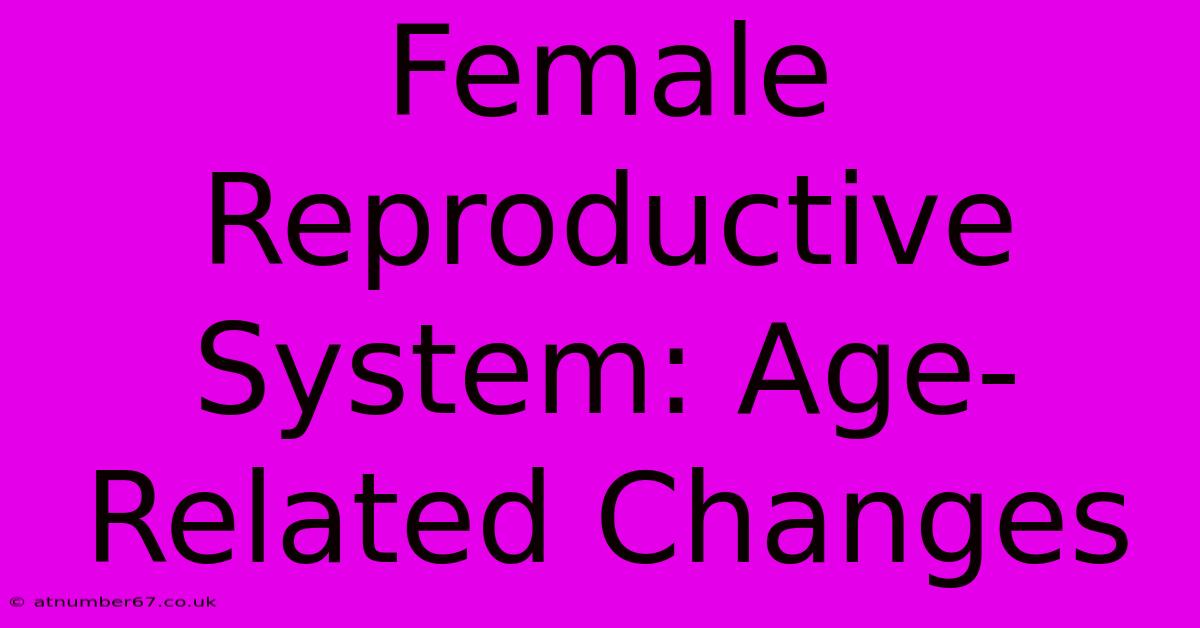Female Reproductive System: Age-Related Changes

Table of Contents
Female Reproductive System: Age-Related Changes
The female reproductive system undergoes significant changes throughout a woman's life, most notably during puberty, pregnancy, and menopause. Understanding these age-related changes is crucial for maintaining reproductive health and overall well-being. This comprehensive guide explores the key transformations the female reproductive system experiences as a woman ages.
Puberty: The Onset of Fertility
Puberty, typically beginning between 8 and 13 years old, marks the start of the female reproductive system's maturation. Key changes include:
- Menarche: The onset of menstruation, signifying the beginning of ovulation and the potential for pregnancy.
- Breast Development: Growth and development of breasts, driven by hormonal changes.
- Growth Spurt: A rapid increase in height and weight.
- Development of Secondary Sexual Characteristics: Appearance of pubic and underarm hair.
Understanding these changes is vital for parents and young girls to navigate this significant developmental stage. Early or delayed puberty can indicate underlying health issues requiring medical attention.
Reproductive Years: Peak Fertility and Cyclical Changes
The reproductive years, spanning from menarche to menopause, are characterized by cyclical changes in hormone levels, which regulate the menstrual cycle and ovulation. These cycles typically occur monthly, with variations in length and intensity being normal. During this period:
- Ovulation: A mature egg is released from an ovary, creating a window of opportunity for fertilization.
- Menstruation: The shedding of the uterine lining if fertilization doesn't occur.
- Hormonal Fluctuations: Estrogen and progesterone levels rise and fall throughout the cycle, influencing mood, energy levels, and physical symptoms.
Maintaining a healthy lifestyle during these years is crucial for optimal reproductive health. This includes regular exercise, a balanced diet, and stress management techniques. Regular gynecological checkups are also essential for early detection of potential problems.
Perimenopause: The Transition to Menopause
Perimenopause, the transitional phase leading to menopause, typically begins in a woman's 40s and can last for several years. During this period, the ovaries gradually produce less estrogen and progesterone, leading to a range of symptoms, including:
- Irregular Menstrual Cycles: Periods may become shorter, longer, heavier, or lighter.
- Hot Flashes: Sudden sensations of intense heat, often accompanied by sweating.
- Sleep Disturbances: Insomnia and difficulty sleeping.
- Mood Swings: Increased irritability, anxiety, or depression.
- Vaginal Dryness: Reduced lubrication can lead to discomfort during intercourse.
Managing perimenopausal symptoms often involves lifestyle adjustments and, in some cases, hormone replacement therapy (HRT). Consulting a healthcare professional is recommended to discuss appropriate management strategies.
Menopause: The Cessation of Menstruation
Menopause is defined as the cessation of menstruation for 12 consecutive months, typically occurring around age 51. Once menopause is reached:
- Ovulation ceases: Pregnancy is no longer possible naturally.
- Estrogen levels decline significantly: This leads to long-term health consequences, including an increased risk of osteoporosis, cardiovascular disease, and cognitive decline.
- Vaginal atrophy: Thinning and dryness of the vaginal walls.
Maintaining a healthy lifestyle, including regular exercise, a balanced diet rich in calcium and vitamin D, and strategies for bone health are crucial during and after menopause. Regular checkups with a healthcare provider are essential for managing potential health risks.
Postmenopause: Long-Term Health Considerations
The period after menopause is called postmenopause. During this phase, women face an increased risk of several health issues, including:
- Osteoporosis: Weakening of bones, increasing the risk of fractures.
- Cardiovascular Disease: Heart disease and stroke.
- Urinary Incontinence: Involuntary leakage of urine.
- Cognitive Decline: Increased risk of dementia and Alzheimer's disease.
Regular screenings and preventative measures are vital during postmenopause to mitigate these risks. This includes bone density scans, regular cardiovascular checkups, and a healthy lifestyle focused on diet, exercise, and stress management.
Conclusion:
Understanding the age-related changes in the female reproductive system is vital for maintaining optimal health and well-being throughout a woman's life. Regular checkups with a healthcare provider, a healthy lifestyle, and proactive management strategies are crucial for navigating each stage successfully. Early intervention can significantly improve the quality of life and reduce the risk of age-related health problems.

Thank you for visiting our website wich cover about Female Reproductive System: Age-Related Changes. We hope the information provided has been useful to you. Feel free to contact us if you have any questions or need further assistance. See you next time and dont miss to bookmark.
Featured Posts
-
Fix Its Net Worth Start Your Financial Journey Today
Mar 29, 2025
-
Pewdiepies Net Worth Will It Reach A Billion
Mar 29, 2025
-
Unlocking The Secrets Of J K Rowlings Wealth
Mar 29, 2025
-
Rei Germar Celebrating Life At Any Age
Mar 29, 2025
-
Nepals Marriage Age Protecting Girls Education
Mar 29, 2025
